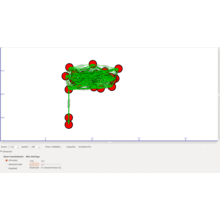Cybersecurity is the art of taking effective preventive measures against cyber-attacks for safeguarding the network/system (hardware/interface). This page showcases the important PhD topics in cybersecurity with interesting subject information!!! The main objective of cybersecurity is to ensure high security by minimizing the extreme possible security risk, vulnerability, threats, and attacks. Further, it also motivated to prevent illegal system access and exploitation.
We hope you are clear about what cybersecurity actually means. Now, we can see in what way we can detect security violations in the cyber system since cybersecurity breach is the foremost challenging process to be concentrated.

Innovative PhD Topics in Cyber Security
- New Design of Security Architectures
- Secure Communication protocols, Hardware, and Software
- Efficient Threat modeling for Network / Host Security
- Enhancing Mechanisms of Security and Risk Control
- Evolving Techniques in Access Control
- Advance Defensive Measures for Real-time Network Observation
- Application Layer Safety in Cybersecurity Engineering
- Intrusion Identification, Visualisation and Prevention Techniques
- Performance Evaluation of the Vulnerable System
- Digital Forensics for Cyber System Incident Response
- Emerging Technologies in Cyber-Physical / Information Communication System
- Edge Security in Data Transmission using Cryptographic Techniques
- Impact of Malicious Cyber Weapons and Malware
How to detect the cybersecurity breach?
- Abnormal transactions of data. For instance: transferring voluminous data
- Mysteriously unable to access the network, and personal / official accounts
- Weirdly browser display the warning / error symbol to stop the access
- Stealing the system passwords to access the private accounts
- Creating unexpected variation in network structure
- Sudden loss of important records
- Strange disturbance in internet connectivity which blocks the access
- Finding the distrustful file in your system which either encrypted or decrypted
- Doubtful activity which are not performed before. For instance: accessing strange data at strange time
Further, we have also listed few essential modules required to develop promising result-yield security technologies in cyber systems. These modules have already reached a significant position in the research community to develop cyber security master thesis .
What are the modules in cyber security?
- Cybersecurity Engineering
- Adversaries Penetration Test
- Cyber Security Foundations
- Network and Host-based Security
- Malware Mounting and Analysis
- Intelligent Cyber-Threat Framework
- Digital Forensics Analysis (Evidences)
- Incident Response Plan and Policies
What is an example of a security threat?
Data Security Threat is one of the major threats in cybersecurity. It is fully data-intensive extortions that create information interference, malfunction, disruption, theft (identity, assets, and tools), and more. Basically, recognizing the cyber-attacks is a tedious process in the cyber system. However, we can get to know the presence of intrusion / cyber-breach based on some indicators. For your awareness, we have categorized some attacks based on the effect of real-time deployment in the following,
Classification of Cyber Attacks
- Network Design and Data Transmission Technology
- Node Cloning
- Blackhole and wormhole attack
- Selective forwarding attack
- Sybil and Masquerading attack
- Denial of Service attack
- Manipulating CSMA Protocol
- Congestion and Collision attack
- ID Spoofing
- Eavesdropping / Man-in-the-Middle attacks
- Physical Security and Geo-Location Track
- Node Tamper and Replication
- Geo based Device and Data Capture
- Invasive and Semi-invasive Intrusion
- Device Abuse and Timing Attack
- Network Separation
- DoS attacks
- Hardware Compromise
- Unauthenticated / Unauthorised user attempt to enter into network
- Virtualization of Network
- DoS and Distributed Dos (IoT Security)
- Illegal Entry into network / devices (via IP)
- Centralized / Decentralized Network
- Information Revelation
- Malware and Storage attacks
- Data Alteration and Deletion
- Confidentiality Threats
- Denial of Service (Cooperated Device error / failure)
- Illegitimate User Communication
From the above, you gain knowledge on current cyber-attacks. Now, we can see how the real cyber-attacks’ effect is greatly evaluated. Here, the network is classified into two categories such as host/device control and information control. In each category, we have discussed the list of applicable attacks with their occurrence conditions cyber security thesis ideas. Further, we also included the impact of the attacks.
How to assess the impact of cybersecurity attacks?
- Host / Device Control
- Attacks – Sniffing, Cookie Hijacking, DDoS, Energy Exhaustion, Backdoor Trojan, DoS and Transport Layer Attack
- Applicable Situations
- Port scanning / sweeping for penetrating the network in order to achieve the access rights of the main server
- Extracting or interfering the link of secret key or temporary session
- Reject the security technique and uncover the defects of the system
- Impacts / Limitations
- Damage / Breach the security techniques
- Make the network not to response on malicious activities
- Access the network resource without proper rights
- Reveal the network weaknesses and acquire the unlawful access
- Make the host and employee to face security risks
- Information Control
- Attacks – Phishing, Routing, MitM, Password guessing, Side channel, Spoofing, Ransomware and Power-analysis
- Applicable Situations
- Alter the route for packets exfiltration and get the core data
- Withdraw the private key and using that decrypt the encrypted data
- Misusing weakened system to encode the core data
- Impression
- Forge the original data
- Intentionally damage the data to create huge loss
- Make the system not accessible or the steal the data
- Access the data without permission for encrypt or decrypt the data
For an illustration, we have selected Man-in-the-Middle (MiM) attack from the above attacks list to give detailed information.
What is man in the middle in cyber security?
In MitM, the attackers inject themselves into the network to create an interruption to the conversation. Further, the attacker can overhear the legitimate users’ private messages while transmitting and pretending to act as legal users. Below, we have specified the different types of MitM attacks.
What are the types of man in the middle MITM attacks?
- HTTPS / SSL Spoofing
- Session or Cookie Hijacking
- Cache Poisoning (ARP and DNS)
- Eavesdropping (Wi-Fi Network)

How Does A Man-in-the-Middle Attack Work?
The hackers silently get into the network to monitor, manipulate and add unwanted data into the channel. Certainly, it creates a major issue for the organization/individual. Even Virtual Private Network (VPN) and Secure Socket protocols may have the probability of missing those interceptions in the network. Here, we have given you the working process of the man in the middle network attack for your reference,
- At first, the eavesdropper successfully enter into the discussion
- Then, the data exchange process takes place between sender and receiver
- Next, the attacker interfere into discussion
- At last, attacker overhears or modifies the data secretly
What procedure can prevent man in the middle attacks?
In order to prevent the MitM attack, employ a strong VPN to encode the whole communication channel. As a result, it surely restricts hackers from accessing web traffic. Even if they try to change the data, it won’t work as well. In addition, we have also given you the other important preventive measures of MitM.
- Quantum Cryptography – Majorly utilize the quantum computing for ensuring the security in cryptographic techniques
- Cryptanalysis – Decode the encoded data without having the awareness on those encryption techniques
- Mutual Verification – Interacting with other parties to create the trust among themselves about each one identities
- Key Management – Handling of cryptographic keys which incorporates all the key generation, distribution, verification and storage processes
- Protected Channel – Represents how the data transmission takes place against interruption
- Password-Validated Key Agreement – Addresses the protocol used to create key using validated password
- Digital Signature – Verify the identity of the message where only the authenticated user can handle
- Interlock protocol – When there is the possibility of compromised key, mount the particular protocol which prevent the man-in-the-middle attack
What are the behavioral warning signs of cyber threat?
Detecting the insider threats in real-time will depends on some indicators. Here, our team has shown you very few common patterns of insider threats.
How to Detect Insider Threat Behavior?
- Try to access the data which are not accessed so far
- Uploading or downloading huge volume of data
- Demanding the services that are essential
- Attempting to access the confidential data which completely irrelevant
Guidelines for PhD Topics in Cyber Security Framework Design
Next, we can see the major precaution measures to be taken while designing a cybersecurity system. Here, we have classified the countermeasures based on remedy, incident response, system vulnerability, and detection. In fact, we have a set of PhD Topics in Cyber Security in the following risk assessment area.
- Remedial Countermeasures
- Node Failure Recovery
- Remote Code Attestation (Integrity)
- Self- Healing
- Node Failure Recovery
- Incident Reactive Countermeasures
- Controlled Hardware Segregation
- Infected Nodes Banning or Cancelation
- Techniques of Anti-tamper
- Break the connectivity of Failure Entity in the network
- Recover the sensitive content from System Backup
- Weakness Evaluation / Penetration Test
- Device / Key / ID Attestation
- Network Verification
- Detection Countermeasures
- Log Files Maintenance
- Safety Inspection
- Network Edge Analysis
- Cognitive based IoT Safety
- Deep Machine Learning Algorithms
- Mining Methods for Data Analysis
- Security Information and Event Management (SIEM)
- Security Hardening Gateway
- Firmware and Remote Attestation
Next, we can see countermeasures related to cyber-attacks. Our experts suggest these measures. Once you tie-up with us, we let you know more updates on these measures based on the research problem.
Prevention Measures for Cyber Attacks
- Manage and control the accessibility of the user by strong authentication scheme (multi-factor)
- Create the trustable platform for data computing
- Ensure the truthfulness of the hardware and software
- Securely maintain the each possible fixing or open port
Our research team has more than enough knowledge of all current research areas due to their tireless effort to study all recent research journal papers, articles, and magazines. So, we are adept at working with any kind of new technologies efficiently.
On the whole, we promise you that we will certainly deliver fine-tuned PhD/MS research service in your interested area. Our research and development team co-operatively puts maximum effort into making Research PhD Topics in Cyber Security work easy for you.

 Click Here to watch our latest output video using NS3 simulator
Click Here to watch our latest output video using NS3 simulator  Click Here to watch our latest projects screenshots using NS3 simulator
Click Here to watch our latest projects screenshots using NS3 simulator